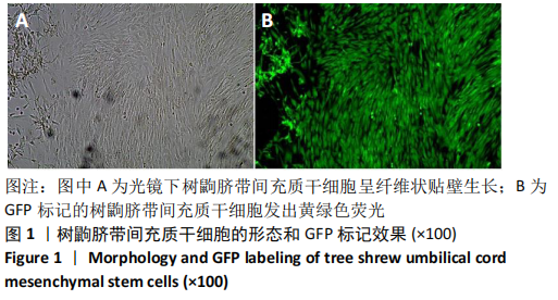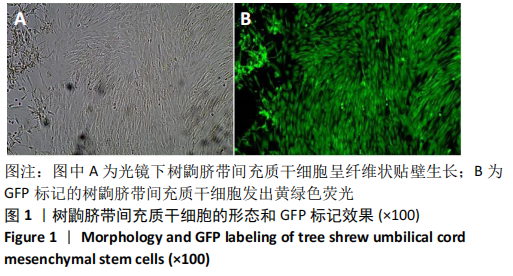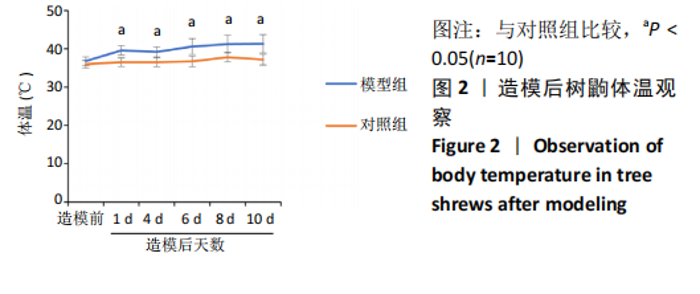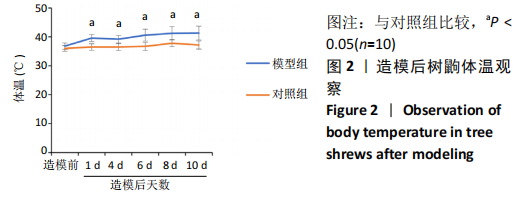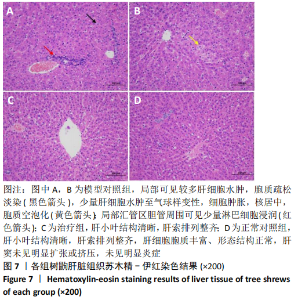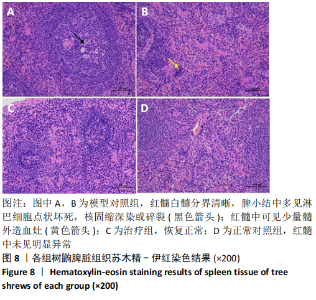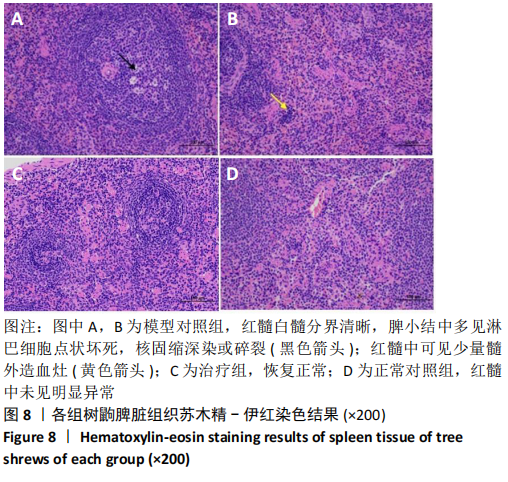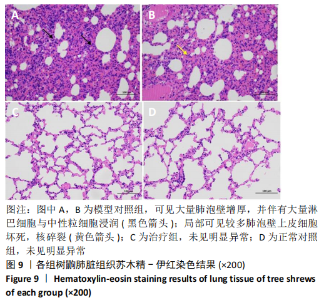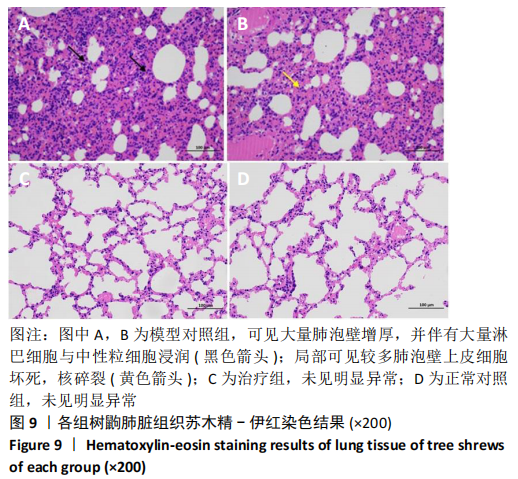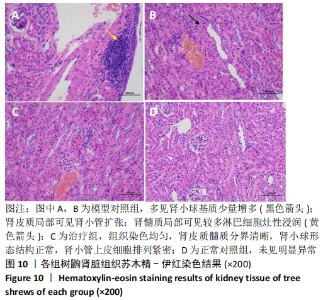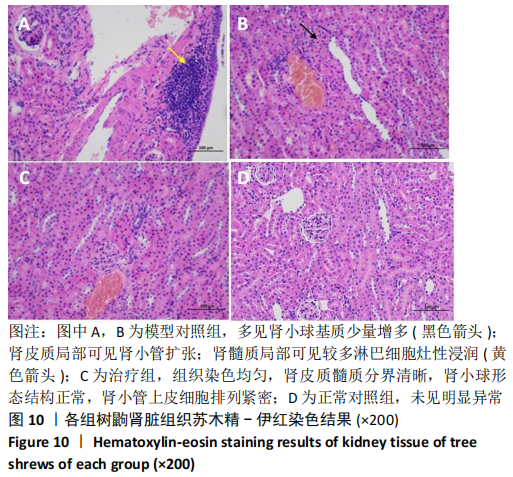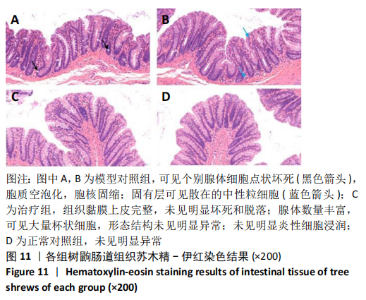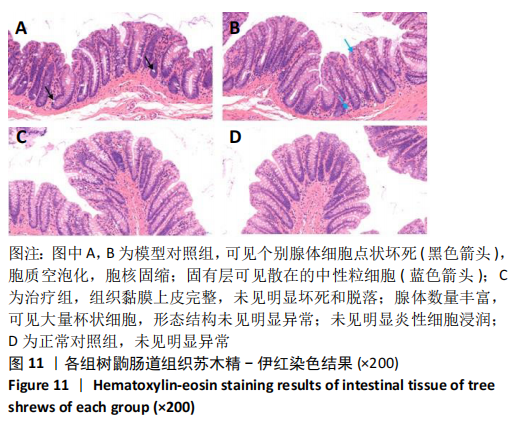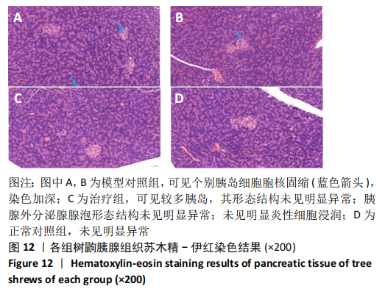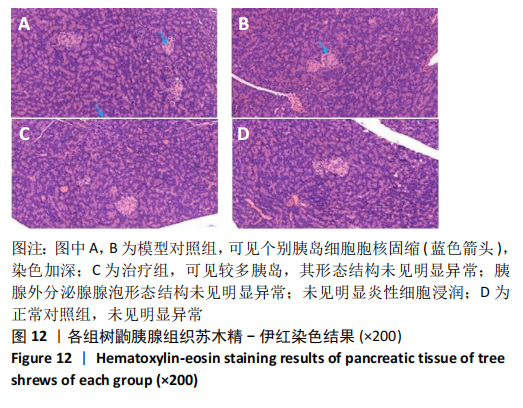Chinese Journal of Tissue Engineering Research ›› 2021, Vol. 25 ›› Issue (25): 3994-4000.doi: 10.12307/2021.010
Previous Articles Next Articles
Umbilical cord mesenchymal stem cell transplantation for traumatic systemic inflammatory response syndrome in tree shrews
Ruan Guangping1, 2, 3, Yao Xiang1, 2, 3, Liu-Gao Miyang1, 2, 3, Cai Xuemin1, 2, 3, Li Zian1, 2, 3, Pang Rongqing1, 2, 3, Wang Jinxiang1, 2, 3, #br# Pan Xinghua1, 2, 3#br#
- 1Basic Medical Laboratory of 920 Hospital of Joint Logistics Support Force of PLA, Kunming 650032, Yunnan Province, China; 2Integrated Engineering Laboratory of Cell Biological Medicine of State and Regions, Kunming 650032, Yunnan Province, China; 3Transfer Medicine Key Laboratory of Cell Therapy Technology of Yunan Province, Kunming 650032, Yunnan Province, China
-
Received:2020-06-05Revised:2020-06-06Accepted:2020-07-29Online:2021-09-08Published:2021-03-25 -
Contact:Pan Xinghua, MD, Chief physician, Basic Medical Laboratory of 920 Hospital of Joint Logistics Support Force of PLA, Kunming 650032, Yunnan Province, China; Integrated Engineering Laboratory of Cell Biological Medicine of State and Regions, Kunming 650032, Yunnan Province, China; Transfer Medicine Key Laboratory of Cell Therapy Technology of Yunan Province, Kunming 650032, Yunnan Province, China -
About author:Ruan Guangping, MD, Associate chief physician, Basic Medical Laboratory of 920 Hospital of Joint Logistics Support Force of PLA, Kunming 650032, Yunnan Province, China; Integrated Engineering Laboratory of Cell Biological Medicine of State and Regions, Kunming 650032, Yunnan Province, China; Transfer Medicine Key Laboratory of Cell Therapy Technology of Yunan Province, Kunming 650032, Yunnan Province, China -
Supported by:the Yunnan Science and Technology Plan Project Major Science and Technology Project, No. 2018ZF007 (to PXH); the Yunnan Province Applied Basic Research Program Key Project, No. 2018FA041 (to PXH), No. 2017FA040 (to RGP); National Natural Science Foundation of China, No. 31970515 (to PRQ); 920 Hospital of the PLA Joint Logistics Support Force In-Hospital Technology Plan, No. 2019YGB17 (to RGP), No. 2019YGA05 (to PRQ); The Whole Army Experimental Animal Special Project, No. SYDW[2016]004 (to LGMY).
CLC Number:
Cite this article
Ruan Guangping, Yao Xiang, Liu-Gao Miyang, Cai Xuemin, Li Zian, Pang Rongqing, Wang Jinxiang, Pan Xinghua. Umbilical cord mesenchymal stem cell transplantation for traumatic systemic inflammatory response syndrome in tree shrews[J]. Chinese Journal of Tissue Engineering Research, 2021, 25(25): 3994-4000.
share this article
Add to citation manager EndNote|Reference Manager|ProCite|BibTeX|RefWorks

2.5 模型对照组、治疗组、正常对照组各脏器苏木精-伊红染色结果 ①心脏组织苏木精-伊红染色结果:模型对照组可见较多心肌纤维水肿,胞质疏松淡染(黑色箭头),治疗组恢复到接近正常对照组,见图6。②肝脏组织苏木精-伊红染色结果:模型对照组局部可见较多肝细胞水肿,胞质疏松淡染(黑色箭头),少量肝细胞水肿至气球样变性,细胞肿胀,核居中,胞质空泡化(黄色箭头);局部汇管区胆管周围可见少量淋巴细胞浸润(红色箭头)。治疗组恢复到接近正常对照组,见图7。③脾脏组织苏木精-伊红染色结果:模型对照组脾小结中多见淋巴细胞点状坏死,核固缩深染或碎裂(黑色箭头);红髓中可见少量髓外造血灶(黄色箭头)。治疗组恢复到接近正常对照组,见图8。④肺脏组织苏木精-伊红染色结果:模型对照组可见大量肺泡壁增厚,并伴有大量淋巴细胞与中性粒细胞浸润(黑色箭头);局部可见较多肺泡壁上皮细胞坏死,核碎裂(黄色箭头)。治疗组恢复到接近正常对照组,见图9。⑤肾脏组织苏木精-伊红染色结果:模型对照组多见肾小球基质少量增多(黑色箭头);肾皮质局部可见肾小管扩张;肾髓质局部可见较多淋巴细胞灶性浸润(黄色箭头)。治疗组恢复到接近正常对照组,见图10。⑥肠道组织苏木精-伊红染色结果:模型对照组可见个别腺体细胞点状坏死(黑色箭头),胞质空泡化,胞核固缩;固有层可见散在的中性粒细胞(蓝色箭头)。治疗组恢复到接近正常对照组,见图11。⑦胰腺组织苏木精-伊红染色结果:模型对照组个别胰岛细胞胞核固缩(蓝色箭头),染色加深。治疗组恢复到接近正常对照组,见图12。"

| [1] ANDERSON SL, SINGH B. Neutrophil apoptosis is delayed in an equine model of colitis: Implications for the development of systemic inflammatory response syndrome. Equine Vet J. 2017;49(3):383-388. [2] GARCÍA-LAMBERECHTS EJ, MARTÍN-SÁNCHEZ FJ, JULIÁN-JIMÉNEZ A, et al. Infection and systemic inflammatory response syndrome in older patients in the emergency department: a 30-day risk model. Emergencias. 2018;30(4):241-246. [3] LI T, SUN XZ, LAI DH, et al. Fever and systemic inflammatory response syndrome after retrograde intrarenal surgery: Risk factors and predictive model. Kaohsiung J Med Sci. 2018;34(7):400-408. [4] MAHASSADI AK, NGUIEGUIA JLK, KISSI HY, et al. Systemic inflammatory response syndrome and model for end-stage liver disease score accurately predict the in-hospital mortality of black African patients with decompensated cirrhosis at initial hospitalization: a retrospective cohort study. Clin Exp Gastroenterol. 2018;11:143-152. [5] FAN Y, HUANG ZY, CAO CC, et al. Genome of the Chinese tree shrew. Nat Commun. 2013;4:1426. [6] WAGNER R, PILER P, UCHYTIL B, et al. Systemic inflammatory response syndrome is reduced by preoperative plasma-thrombo-leukocyte aphaeresis in a pig model of cardiopulmonary bypass. Biomed Pap Med Fac Univ Palacky Olomouc Czech Repub. 2016;160(3):399-406. [7] WARD L, PAUL M, ANDREASSEN S. Automatic learning of mortality in a CPN model of the systemic inflammatory response syndrome. Math Biosci. 2017;284:12-20. [8] XU R. Combination of Systemic Inflammatory Response Syndrome and Quick-SOFA: Is This a New Vital Model to Initiate or Escalate Therapy in Patients With Sepsis? Chest. 2019;155(1):243-244. [9] 阮光萍,朱路,刘菊芬,等.树鼩脐带间充质干细胞分离、培养及成骨成脂分化的鉴定[J].中国组织工程研究,2017,21(9):1373-1377. [10] SĆAP M, KALENIĆ S. Prevention of wound infection in craniocerebral war injuries. Lijec Vjesn. 1991;113(7-8):289. [11] SCEPI M. Evaluation of the severity and extent of early complications in burns, multiple trauma, abdominal injuries, craniofacial injuries, injuries of the extremities, thoracic injuries, preceding injuries of soft tissues. Part 4--preceding injuries of soft tissues. Rev Prat. 2007;57(3):337-343. [12] XU T, SHEN MY, WANG XG, et al. Treatment and nursing of one patient with burns on perineal region and complicated by secondary multiple organ injuries by exposing to paraquat fluid. Zhonghua Shao Shang Za Zhi. 2019;35(7):546-547. [13] HADZIAHMETOVIĆ Z. The effect of organization of treatment of injuries on the occurrence of late complications of fractures caused by gunshots and explosions in war. Med Arh. 1995;49(3-4):83-86. [14] KLAUSNER JM, ROZIN RR. Late abdominal complications in war wounded. J Trauma. 1995;38(2):313-317. [15] PATZKOWSKI JC, BLAIR JA, SCHOENFELD AJ, et al. Multiple associated injuries are common with spine fractures during war. Spine J. 2012; 12(9):791-797. [16] YEE MK, JANULEWICZ PA, SEICHEPINE DR, et al. Multiple Mild Traumatic Brain Injuries Are Associated with Increased Rates of Health Symptoms and Gulf War Illness in a Cohort of 1990-1991 Gulf War Veterans. Brain Sci. 2017;7(7):79. [17] DEL SORBO L, SLUTSKY AS. Acute respiratory distress syndrome and multiple organ failure. Curr Opin Crit Care. 2011;17(1):1-6. [18] HUANG PM, LIN TH, TSAI PR, et al. Intrapleural steroid instillation for multiple organ failure with acute respiratory distress syndrome. Shock. 2013;40(5):392-397. [19] LEE BJ, CHEN CY, HU SY, et al. Otalgia and eschar in the external auditory canal in scrub typhus complicated by acute respiratory distress syndrome and multiple organ failure. BMC Infect Dis. 2011;11:79. [20] TOURTIER JP, LIBERT N, LECLERC T, et al. Effects of simulated altitude on ventilator performance: interest of acute respiratory distress syndrome and asthma lung models. J Trauma. 2010;68(3):749-750. |
| [1] | Pu Rui, Chen Ziyang, Yuan Lingyan. Characteristics and effects of exosomes from different cell sources in cardioprotection [J]. Chinese Journal of Tissue Engineering Research, 2021, 25(在线): 1-. |
| [2] | Lin Qingfan, Xie Yixin, Chen Wanqing, Ye Zhenzhong, Chen Youfang. Human placenta-derived mesenchymal stem cell conditioned medium can upregulate BeWo cell viability and zonula occludens expression under hypoxia [J]. Chinese Journal of Tissue Engineering Research, 2021, 25(在线): 4970-4975. |
| [3] | Zhang Yu, Tian Shaoqi, Zeng Guobo, Hu Chuan. Risk factors for myocardial infarction following primary total joint arthroplasty [J]. Chinese Journal of Tissue Engineering Research, 2021, 25(9): 1340-1345. |
| [4] | Tang Hui, Yao Zhihao, Luo Daowen, Peng Shuanglin, Yang Shuanglin, Wang Lang, Xiao Jingang. High fat and high sugar diet combined with streptozotocin to establish a rat model of type 2 diabetic osteoporosis [J]. Chinese Journal of Tissue Engineering Research, 2021, 25(8): 1207-1211. |
| [5] | Chai Le, Lü Jianlan, Hu Jintao, Hu Huahui, Xu Qingjun, Yu Jinwei, Quan Renfu. Signal pathway variation after induction of inflammatory response in rats with acute spinal cord injury [J]. Chinese Journal of Tissue Engineering Research, 2021, 25(8): 1218-1223. |
| [6] | Zhang Xiumei, Zhai Yunkai, Zhao Jie, Zhao Meng. Research hotspots of organoid models in recent 10 years: a search in domestic and foreign databases [J]. Chinese Journal of Tissue Engineering Research, 2021, 25(8): 1249-1255. |
| [7] | Wang Xianyao, Guan Yalin, Liu Zhongshan. Strategies for improving the therapeutic efficacy of mesenchymal stem cells in the treatment of nonhealing wounds [J]. Chinese Journal of Tissue Engineering Research, 2021, 25(7): 1081-1087. |
| [8] | Liao Chengcheng, An Jiaxing, Tan Zhangxue, Wang Qian, Liu Jianguo. Therapeutic target and application prospects of oral squamous cell carcinoma stem cells [J]. Chinese Journal of Tissue Engineering Research, 2021, 25(7): 1096-1103. |
| [9] | Xie Wenjia, Xia Tianjiao, Zhou Qingyun, Liu Yujia, Gu Xiaoping. Role of microglia-mediated neuronal injury in neurodegenerative diseases [J]. Chinese Journal of Tissue Engineering Research, 2021, 25(7): 1109-1115. |
| [10] | Li Shanshan, Guo Xiaoxiao, You Ran, Yang Xiufen, Zhao Lu, Chen Xi, Wang Yanling. Photoreceptor cell replacement therapy for retinal degeneration diseases [J]. Chinese Journal of Tissue Engineering Research, 2021, 25(7): 1116-1121. |
| [11] | Jiao Hui, Zhang Yining, Song Yuqing, Lin Yu, Wang Xiuli. Advances in research and application of breast cancer organoids [J]. Chinese Journal of Tissue Engineering Research, 2021, 25(7): 1122-1128. |
| [12] | Wang Shiqi, Zhang Jinsheng. Effects of Chinese medicine on proliferation, differentiation and aging of bone marrow mesenchymal stem cells regulating ischemia-hypoxia microenvironment [J]. Chinese Journal of Tissue Engineering Research, 2021, 25(7): 1129-1134. |
| [13] | Zeng Yanhua, Hao Yanlei. In vitro culture and purification of Schwann cells: a systematic review [J]. Chinese Journal of Tissue Engineering Research, 2021, 25(7): 1135-1141. |
| [14] | Kong Desheng, He Jingjing, Feng Baofeng, Guo Ruiyun, Asiamah Ernest Amponsah, Lü Fei, Zhang Shuhan, Zhang Xiaolin, Ma Jun, Cui Huixian. Efficacy of mesenchymal stem cells in the spinal cord injury of large animal models: a meta-analysis [J]. Chinese Journal of Tissue Engineering Research, 2021, 25(7): 1142-1148. |
| [15] | Hou Jingying, Yu Menglei, Guo Tianzhu, Long Huibao, Wu Hao. Hypoxia preconditioning promotes bone marrow mesenchymal stem cells survival and vascularization through the activation of HIF-1α/MALAT1/VEGFA pathway [J]. Chinese Journal of Tissue Engineering Research, 2021, 25(7): 985-990. |
| Viewed | ||||||
|
Full text |
|
|||||
|
Abstract |
|
|||||
